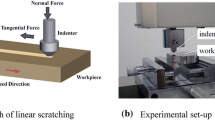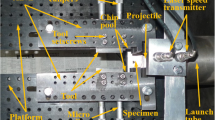Abstract
The plastic flow characteristics of the metal material in mechanical scratching is determined on the important parameters of the negative rake angle, the material deformation amount, the scratching force, the groove quality, and the tool wear. However, the chip flow angle and the plastic flow direction of the metal material in the cutting or mechanical scratching are often derived from the approximate solution according to the metal cutting theory and assumptions. Meanwhile, there is no theoretical model of the plastic flow characteristics suitable for the mechanical scratching the metal material with diamond wedge scratching tool (irregular triangular pyramid tool). Therefore, the unit plastic flow vector (PFV), the working negative rake angle, and the chip flow angle (CFA) theoretical model are established in this paper. And the evolution law of plastic flow angle of the unit PFV and CFA under the influence of the multi-scratching factors was also studied. It can be known that the PFA is related to the elevation angle of the scratching tool, but independent on the speed and material, while the CFA is related to the above multi-scratching factors. Meanwhile, the evolution law of theoretical PFA is consistent with the experimental value, and the maximum deviation is 6.687°, which verifies the theoretical model. In addition, compared with the CFA, the PFV can directly reflect the material plastic flow direction on the contact surface.










Similar content being viewed by others
Data Availability
The datasets used or analyzed during the current study are available from the corresponding author on reasonable request.
Abbreviations
- CFA:
-
Chip flow angle
- PFV:
-
Plastic flow vector
- PFA:
-
Plastic flow angle
References
Ding Y, Shi G, Shi G (2018) Analysis of the stagnant characteristics of the material in the mechanical ruling process. J Mech Eng 54(19):182–189
Yan Y, Sun Y, Yang Y, Hu Z, Zhao X (2012) Effects of the AFM tip trace on nanobundles formation on the polymer surface. Appl Surf Sci 258:9656–9663
Yan Y, Geng Y, Hu Z (2015) Recent advances in AFM tip-based nanomechanical machining. Int J Mach Tools Manuf 99:1–18
Chamani HR, Ayatollahi MR (2016) The effect of Berkovich tip orientations on friction coefficient in nanoscratch testing of metals. Tribol Int 103:25–36
Tseng AA, Kuo CFJ, Jou S, Nishimura S, Shirakashi J (2011) Scratch direction and threshold force in nanoscale scratching using atomic force microscopes. Appl Surf Sci 257(22):9243–9250
Stabler GV (1951) The fundamentals geometry of cutting tools. Proc Inst Mech Eng 165:14–21
Stabler GV (1964) The chip flow law and its consequences. Proc. 5th Int, MTDR Conf 243-251
Colwell LV (1954) Prediction the angle of chip flow for single point cutting tools. Trans ASME 76(2):199–204
Russell JK, Brown RH (1966) The measurement of chip flow direction. Int J Mach Tool Des Res 6:129–138
Hu RS, Mathew P, Oxley PLB et al (1986) Allowing for end cutting edge effects in predicting forces in bar turning with oblique machining conditions. Proc Inst Mech Eng C J Mech Eng Sci 200(23):89–99
Young HT, Mathew P, Oxley PLB (1996) Allowing for nose radius effects in predicting the chip flow direction and cutting forces in bar turning. Proc Inst Mech Eng C J Mech Eng Sci 201(3):213–226
Okushima K, Minato K (1958) On the behaviour of chip at steel cutting. Trans Jpn Soc Mech Eng 24(142):333–339
Morcos WA (1972) A solution of the free oblique continuous cutting problem in conditions of light friction at chip-tool interface. J Manuf Sci Eng 94:1124
Luk WK (1972) The direction of chip flow in oblique cutting. Int J Prod Res 10(1):67–76
Shaw MC, Cookson JO (1985) Metal cutting principles. Tribol Int 18(1):55–55
Brown R, Armarego E (1964) Oblique machining with a single cutting edge. Int J Mach Tool Des Res 4(1):9–25
Rubenstein C (1983) The mechanics of continuous chip formation in oblique cutting in the absence of chip distortion. Part 1-Theory. Int J Mach Tool Des Res 23(1):11–20
Armarego EJA, Brown RH (1969) The machining of metals. Prentice Hall, New Jersey
Moufki A, Molinari A, Dudzinski D (1998) Modelling of orthogonal cutting with a temperature dependent friction law. J Mech Phys Solids 46(10):2103–2138
Moufki A, Dudzinski D, Molinari A, Rausch M (2000) Thermoviscoplastic modelling of oblique cutting: Forces and chip flow predictions. Int J Mech Sci 42(6):1205–1232
Usui E, Hirota A, Masuko (1987) Analytical predictions of three dimensional cutting process: part 1 basic cutting model and energy approach. ASME J Eng Ind 100:222–228
Usui E, Hirota A (1978) Analytical prediction of three dimensional cutting process: part 2 chip formation and cutting force with conventional single point tool. ASME J Eng Ind 100:229–235
Wang QM, Lin H, Zhang Z (2011) Prediction of chip flow angle to study the relation between chip flow and ratio of the cutting edge lengths using sharp corner tools. Int J Adv Manuf Technol 56(9-12):841–855
Wan Z, Deng W, Tang Y, Ye B (2008) Variation rules of chip flow angle in double-edge oblique cutting. J S China Univ Technol (Nat Sci Ed) 08:83–87
Xia W, Li YY, Zhou ZH (1997) Mathematical model of gutting forceformed in trapezoid groove cutting. J S China Univ Technol (Nat Sci Ed) 03:7–11
Goddard J, Wilman H (1962) A theory of friction and wear during the abrasion of metals. Wear 5(2):114–135
van der Linde G, De Rooij MB, Schipper DJ (2013) Stability criteria for a pyramidal shaped asperity ploughing through a plastically deforming substrate. Wear 300(1-2):96–104
Tayebi N, Conry TF, Polycarpou AA (2003) Determination of hardness from nanoscratch experiments: Corrections for interfacial shear stress and elastic recovery. J Mater Res 18(09):2150–2162
Komvopoulos K (1991) Sliding Friction Mechanisms of Boundary-Lubricated Layered Surfaces: Part II—Theoretical Analysis. Tribol Trans 34(2):281–291
Briscoe BJ, Biswas SK, Sinha SK, Panesar S (1993) The scratch hardness and friction of a soft rigid-plastic solid. Tribol Trans 26(3):183–193
Subhash G, Zhang W (2002) Investigation of the overall friction coefficient in single pass scratch test. Wear 252:123–134
Lafaye S, Gauthier C, Schirrer R (2005) A surface flow line model of a scratching tip: apparent and true local friction coefficients. Tribol Int 38(2):113–127
Jardret V, Zahouani H, Loubet JL, Mathia TG (1998) Understanding and quantification of elastic and plastic deformation during a scratch test. Wear 218(1):8–14
Wang X, Shi H, Lu T (1997) Bifurcation and mutation in the cutting process. J Mech Eng 06:21–26
Shi G, Liu J, Zhang Y, Shi G (2016) Laser diffraction application on detection technology of online tool setting. International Conference on Optoelectronics & Microelectronics IEEE
Ding Y, Shi G, Zhang H, Shi G, Han D (2019) Analysis of critical negative rake angle and friction characteristics in orthogonal cutting of AL1060 and T2. Sci Prog 103(18):003685041987806
Ding Y, Shi G, Luo X, Shi G, Wang S (2020) Study on the critical negative rake angle of the negative rake angle tool based on the stagnant characteristics in micro-cutting. Int J Adv Manuf Technol 107(5):2055–2064
Ohbuchi Y, Obikawa T (2003) Finite Element Modeling of Chip Formation in the Domain of Negative Rake Angle Cutting. J Eng Mater Technol 125(3):324–332. https://doi.org/10.1115/1.1590999
Acknowledgments
The authors would like to acknowledge the Natural Science Foundation of China (NSFC) (Grant No. 51405031, No. 51575057 and No. 51075042) and the Science and Technology Project of Jilin Province (No. 20180414068GH, 20190302123GX). The authors would like to thank the anonymous reviewers for their valuable comments and suggestions which helped us improve the content quality and presentation of this paper.
Author information
Authors and Affiliations
Contributions
Yanchun Ding: Investigation, theoretical analysis, validation, writing—original draft.
Guangfeng Shi: Conceptualization, supervision, project administration.
Hua Zhang: Investigation, validation, writing—review and editing.
Corresponding author
Ethics declarations
Ethics approval
The authors claim that they are non-life science journals and there are no ethical issues.
Consent to participate
The authors claim that they agree to participate.
Consent for publication
The authors claim that they agree to publish.
Competing interests
The authors declare that they have no competing interests.
Additional information
Publisher’s note
Springer Nature remains neutral with regard to jurisdictional claims in published maps and institutional affiliations.
Rights and permissions
About this article
Cite this article
Ding, Y., Shi, G. & Zhang, H. Research on the plastic flow characteristics of metal material in mechanical scratching. Int J Adv Manuf Technol 115, 1171–1185 (2021). https://doi.org/10.1007/s00170-021-07236-7
Received:
Accepted:
Published:
Issue Date:
DOI: https://doi.org/10.1007/s00170-021-07236-7




